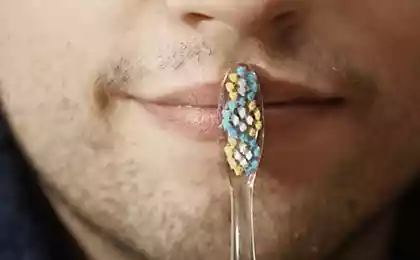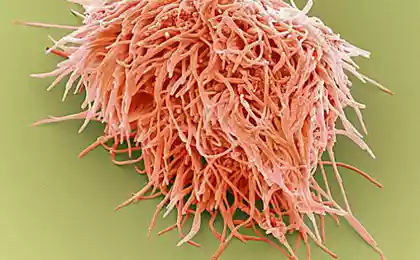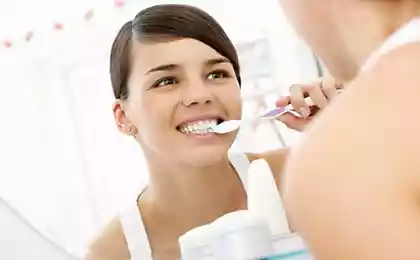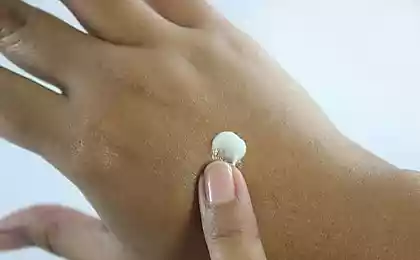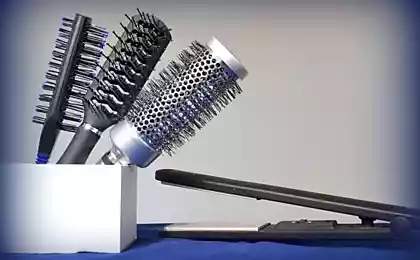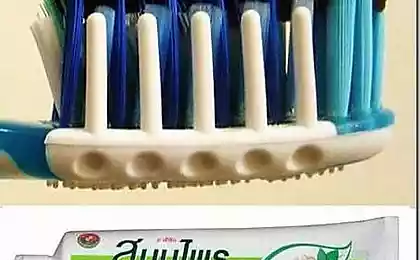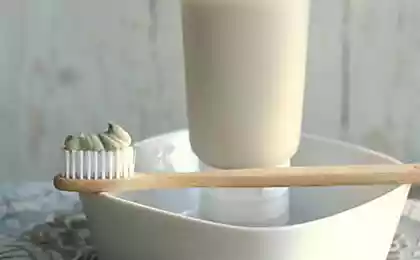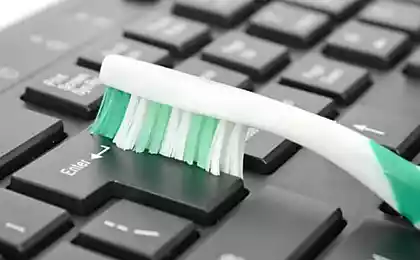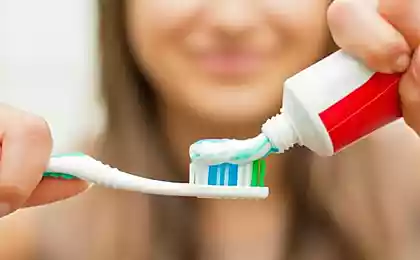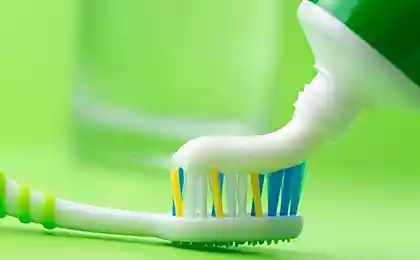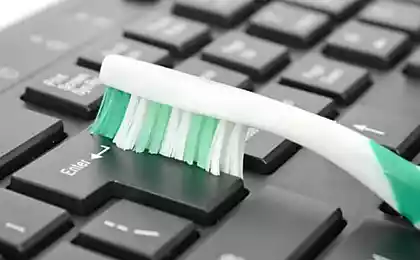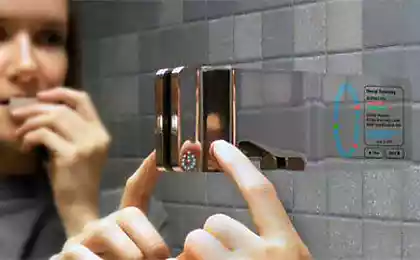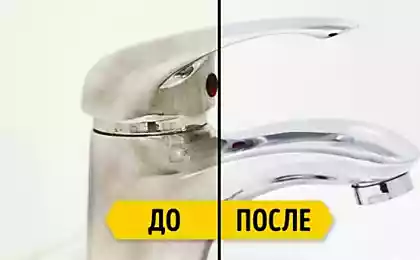1130
The history of the toothbrush
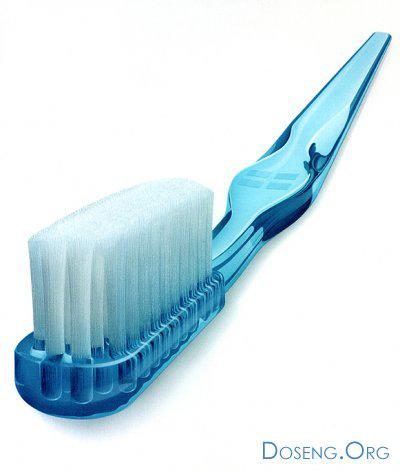
Maybe you ever wondered how many times you can reinvent the toothbrush. Imagine that according to statistics, between 1963 and 1998 was patented more than 3000 models of toothbrushes!
Our ancestors probably understand something in dental hygiene. Leslie Hlusko paleontologist at the University of Illinois says it has data showing the use of the ancient people of rudimentary toothpicks.
It showed that the curved dimples found in fossilized teeth age 1, 8 million years old, may be the result of erosion caused by repeated rubbing steblinmi grass. Skeptics point out that modern toothpicks leave no trace, but, according to Hlusko, abrasive properties of herbs above - because, unlike wood, it contains a lot of solid silicon particles. Hlusko said that grass would have left a mark corresponding to the diameter of the holes - one and a half millimeters to 2, 6. Such a blade of grass growing almost everywhere, and almost did not need to finish to turn in a good toothpick.
It is believed that the ancient hominids began to pick your teeth, trying to ease the pain of dental diseases. Hlusko conducted experiments first tooth baboon, then men, and in both cases it was possible to leave a mark, almost identical to those found on fossil teeth.
It is known that toothpicks were popular in ancient China, Japan, India, Iran and other early Eastern civilizations. They are usually made of mastic, sometimes - in gold or bronze.
The quiet, but very important story toothbrush begins with chewing plates, used by the inhabitants of Babylon many centuries before Christ. Ancient authors very enthusiastically discussed brushing teeth, and if you believe their evidence, a simple plate of chewing gum stick has evolved into a modern size of a pencil. One end of the lovers of cleanliness and hygiene zazhёvyvali to form a wider cleaning surface, the second - were used as toothpicks. By the way, the Romans for a complex case of special cleaning teeth holding slaves. This hygienic ritual was part of religious ceremonies.
These rods - the most primitive version of toothbrushes - are still used by some Australian and African tribes, and according to available data, cleaning them is as effective as their modern counterparts.
The invention in 1498 of the brush with bristles is considered to be a credit to the Chinese. To handle bamboo or bone was attached bristles of the Siberian wild boar. And for that matter boar shaved only the "hair" that grew around his neck.
During the reign of Ivan the Terrible in Russia in the course of the tooth were "broom" - sticks with tufts of bristles at the end of which the boyars enjoyed after a meal.
Peter I ordered boyars to brush their teeth with powdered chalk and a damp cloth. The people had known for a different way: the embers of birch wood perfectly bleached teeth. Here are just rinse your mouth after such cleaning should be especially careful.
In Europe, such a brush came in the seventeenth century and soon gained widespread. Europeans, tooth cleaning brush (there were very few, because at that time the use of the brush was considered indecent occupation - which was more widespread custom to use after a meal with a toothpick made from goose feather, gold or copper), found the pig bristles are too stiff and replaced her horsehair. According to written sources, the French dentists, the most "advanced" specialists in this field in Europe at the time, actively recommend daily use of a toothbrush during the seventeenth and early eighteenth century. Doctors working in the colonized America, also recommended to use it.
Gradually, the natural hair was replaced by nylon, which was invented in 1937 in the laboratories of the company "DuPont de Nemours". The first such brush appeared in 1938. But even toothbrushes with nylon bristles remain very tight, while in 1950, the company Du Pont is not perfected the technology and made of nylon hair softer.
Ironically, the explosion in the hygiene industry and, in particular when it came to cleaning teeth, occurred during World War II, thanks to the military and continued in the post-war period. Houses in Europe and America is flooded with all possible means literally hygiene. The rapidly growing use of plastics technology allows to produce a wide variety of brush shapes and colors.
The idea of an electric toothbrush was proposed back in 1880 by Dr. Scott. Hairs "Electric brushes, Dr. Scott," according to the manufacturers, "has a constant electromagnetic field».
The first real manual toothbrush was patented in Switzerland after World War II and worked from the mains. In 1960, she appeared on the American market. But in 1961, General Electric introduced the first model of a self-powered. Although many this thing seemed overkill, electric toothbrush quickly gained popularity. Later, it appeared different versions: manual toothbrush with a built-in timer, manual toothbrush with replaceable cleaning head, etc.
In the 60s, in addition to the mechanical brushes appear electro-spinning (Rotadent, Interplack and so on. D.). They work like manual brush but with increased abrasion have been rotating at an average speed of 7000 strokes per minute or 58 Hz. These brushes are an order of magnitude more effective than manual, but overly aggressive cleaning can cause damage to the enamel.
In 90 years, there are electric reciprocating rotary brush also works on the principle of abrasion, most of which exist in today's market.
By combining the results of 29 studies, which involved 2,547 people from North America, Europe and Israel, American and British scientists have come to the conclusion that only one type of electric toothbrush - Braun Oral-B, performs rotational-vibrational motion, it acts much more efficient conventional manual .
But the most significant progress in a more "gentle" teeth cleaning has been achieved in the development of sound toothbrushes (Braun Oral B-3D, Sonicart, Panasonic, etc.). They operate at audio frequency, an average of 30,000 per minute or 250 Hz, which allows to achieve deeper and at the same time, "soft" foam cleaning.
In the mid-90s in the United States by Dr. Robert Bock has developed and patented dual-frequency ultrasonic toothbrush Ultrasonex. This brush uses a completely new technology based on ultrasound. Brush 196 moves with a velocity 000 000 strokes per minute (600 or 1 000 Hz), which is more than 6000 times higher than that of sound. In addition to ultrasound, also applies "frothy" af - 18,000 strokes per minute. Bacteria plaque components are arranged and chains attached to the surface of the tooth .. therapeutic ultrasonic waves of frequency 1 MHz 6, these chains break even under the gum (at 5 mm) and a method of fastening destroy bacteria and audio frequency 18 000 strokes per minute or 150 Hz, providing the foaming effect, helps to gently remove the plaque.
12-week study "double blind" method in the Dental Institute Case Western United States, in 2 groups of patients (group 1 - Use a brush with ultrasonic frequency, 2nd - without ultrasound) showed that Ultrasonex with ultrasound was 200 % effective at removing plaque night, 230% - for the treatment of gingivitis, 450% effective in reducing gum bleeding.
Another distinctive feature of the modern toothbrush - rounded bristles. For years, dentists have recommended direct standard toothbrushes is only due to the fact that there was no technology that allows to round off every hair. Round the bristles less traumatic to the tissues of the mouth. Modern production methods allow you to create toothbrushes of various shapes, sizes and models.
Design and marketing idea has not left untouched either one centimeter of the instrument, from the comfortable, non-slip handle, bent, floating, etc. head to the bristles of all shapes and functionality.
For example, a dentist from Glasgow Glen Hivenor at leisure invents ergonomic handle. His assets are already handles for pans, brushes, garden tools and wrench, a pram and a safety razor. But the dream of a dentist has always been, of course, the perfect handle for a toothbrush. According to Glen, we brush our teeth properly, as we just uncomfortable doing it in the most efficient manner. But none of the invention is not to give him so hard, like a toothbrush. Remain without basic work doctor is not afraid, so spent four years and a lot of their own savings in the design and testing of ergonomic brushes. Now a prototype arm is finally ready, but needs to be further developed. To encourage the dentist, the designer, the National Support Group of scientists, inventors, artists, and awarded him a grant of 75 000 pounds.

